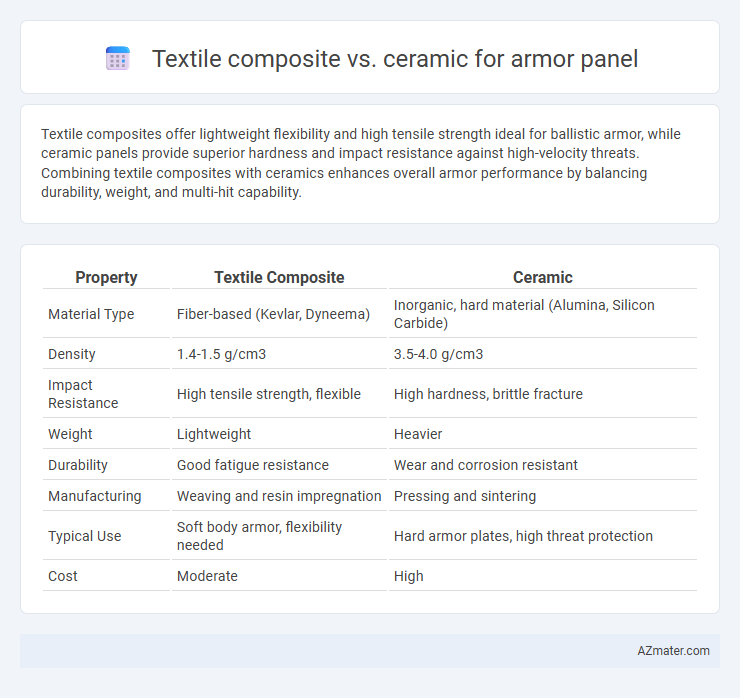Textile composites offer lightweight flexibility and high tensile strength ideal for ballistic armor, while ceramic panels provide superior hardness and impact resistance against high-velocity threats. Combining textile composites with ceramics enhances overall armor performance by balancing durability, weight, and multi-hit capability.
Table of Comparison
| Property | Textile Composite | Ceramic |
|---|---|---|
| Material Type | Fiber-based (Kevlar, Dyneema) | Inorganic, hard material (Alumina, Silicon Carbide) |
| Density | 1.4-1.5 g/cm3 | 3.5-4.0 g/cm3 |
| Impact Resistance | High tensile strength, flexible | High hardness, brittle fracture |
| Weight | Lightweight | Heavier |
| Durability | Good fatigue resistance | Wear and corrosion resistant |
| Manufacturing | Weaving and resin impregnation | Pressing and sintering |
| Typical Use | Soft body armor, flexibility needed | Hard armor plates, high threat protection |
| Cost | Moderate | High |
Introduction to Armor Panel Materials
Textile composites, such as aramid fibers, offer lightweight flexibility and high tensile strength ideal for ballistic protection in armor panels. Ceramic materials like alumina and silicon carbide provide exceptional hardness and compressive strength, effectively disrupting and dissipating high-velocity projectiles. Combining textile composites with ceramic layers creates hybrid armor panels that balance weight reduction with enhanced multi-threat resistance.
Composition of Textile Composites
Textile composites for armor panels consist primarily of high-strength fibers such as aramid, ultra-high-molecular-weight polyethylene (UHMWPE), or carbon fibers, embedded within a polymer matrix like epoxy or thermoplastic resin. These materials provide excellent tensile strength, flexibility, and impact absorption while maintaining lightweight characteristics compared to ceramic composites, which rely on brittle, hard materials like alumina or silicon carbide for ballistic hardness. The fiber orientation and matrix type in textile composites critically influence their energy-dissipating mechanisms, making them suitable for applications requiring durability and multi-hit resistance.
Properties of Ceramic Armor Panels
Ceramic armor panels offer high hardness and exceptional resistance to ballistic impacts, effectively dissipating kinetic energy through cracking and fragmentation. Their low density compared to metals contributes to lightweight protection, making them ideal for personal and vehicular armor systems. Ceramic materials, such as alumina, silicon carbide, and boron carbide, provide superior stopping power against high-velocity projectiles while maintaining structural integrity under extreme conditions.
Weight and Flexibility Comparison
Textile composite armor panels are significantly lighter than ceramic counterparts, offering superior weight efficiency critical for enhanced mobility in protective gear. They provide greater flexibility and resilience under impact, allowing for better contouring and comfort during extended wear. Ceramic armor panels, while heavier and more rigid, excel in hardness and multi-hit ballistic protection but sacrifice flexibility and add substantial weight.
Ballistic Performance Analysis
Textile composites, typically made from aramid or ultra-high-molecular-weight polyethylene fibers, exhibit high tensile strength and energy absorption capabilities, making them effective in dissipating ballistic impact forces. Ceramic armor panels, often silicon carbide or alumina-based, provide exceptional hardness and shatter resistance, enabling rapid projectile deformation and energy dispersion upon impact. Ballistic performance analysis reveals that ceramic-front textile composite-back configurations offer optimized protection by combining ceramic hardness with textile panel flexibility and multi-hit durability.
Durability and Longevity
Textile composites used in armor panels offer high tensile strength and flexibility, providing excellent durability against ballistic impacts and repeated stress without cracking. Ceramic armor panels exhibit superior hardness and wear resistance, effectively stopping high-velocity projectiles, but they are prone to brittle fracture and can degrade over time under harsh environmental conditions. In terms of longevity, textile composites generally maintain structural integrity longer due to their resilience and resistance to environmental factors, while ceramic panels may require more frequent replacement after sustaining damage.
Cost and Manufacturing Considerations
Textile composites generally offer lower manufacturing costs and simpler production processes compared to ceramic armor panels, making them more suitable for large-scale or cost-sensitive applications. Ceramic armor panels require advanced fabrication techniques and longer production times, resulting in higher material and labor expenses. Despite the initial cost difference, ceramic composites provide superior hardness and ballistic performance, influencing cost-effectiveness depending on the specific protection requirements.
Environmental Resistance and Maintenance
Textile composite armor panels offer superior resistance to corrosion and moisture, making them ideal for humid or marine environments with minimal maintenance requirements. In contrast, ceramic armor panels provide excellent hardness and impact resistance but are more susceptible to cracking and environmental degradation such as thermal shocks, necessitating more frequent inspections and careful handling. Textile composites generally require less upkeep and demonstrate longer service life in variable environmental conditions compared to ceramic armor panels.
Application Scenarios and Use Cases
Textile composites are widely used in personal body armor due to their flexibility, lightweight properties, and high tensile strength, making them ideal for military and law enforcement applications requiring mobility and comfort. Ceramic armor panels excel in vehicle and structural armor applications where high hardness and superior ballistic resistance against rifle rounds are critical, often integrated into armored vehicles and fortified installations. Combining textile composites with ceramic plates can optimize protection by enhancing multi-hit resistance and reducing overall weight for tactical gear in combat scenarios.
Future Trends in Armor Panel Materials
Textile composites offer lightweight flexibility and improved multi-hit resistance, making them ideal for next-generation body armor panels, while ceramics provide superior hardness and ballistic protection against high-velocity threats. Future armor materials trend towards hybrid combinations that leverage ceramic front plates for penetration resistance and textile composites for weight reduction and wearer comfort. Innovations in nanomaterials, such as graphene-reinforced textiles and ultra-hard ceramic composites, are driving advancements in armor panels to balance protection, durability, and mobility.

Infographic: Textile composite vs Ceramic for Armor panel
 azmater.com
azmater.com